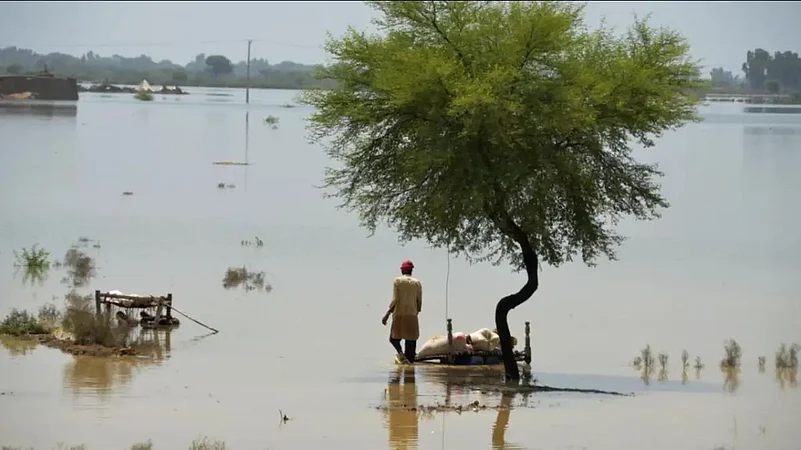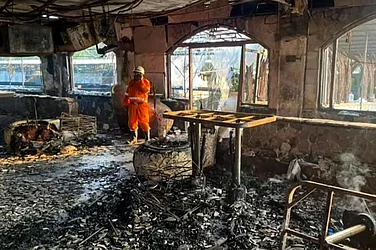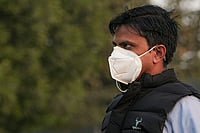The devastation caused by the floods in Pakistan is unprecedented. In televised remarks, Prime Minister Shahbaz Sharif described what he saw in Sindh, one of the worst affected provinces as “a sea of water", adding that he had never seen such devastation in his life before.
After days of heavy rainfall, the floodwaters have started to recede bit by bit, leaving behind over 1,350 people dead, 33 million affected, a third of the country inundated, and losses of more than USD 10 billion. The crisis has prompted the United Nations last week to issue an appeal for USD 160 million in emergency aid for Pakistan's flood victims.
Addressing the media and the world, Sharif called for a "sustainable system" to cope with the challenges of climate change, which is seen as the primary reason that triggered unprecedented rains and floods.
Is flooding in Pakistan a consequence of climate change?
The flooding has all the hallmarks of a catastrophe juiced by climate change, but some experts have found it too early to formally assign blame to global warming.
Pakistan is considered the eighth most vulnerable country to climate change, as per scientists at the International Water Management Institute. Repeated studies have warned of that its rain, heat and melting glaciers are all climate change factors.
And yet, Pakistan did little to cause the warming, but keeps getting hit, just like the relentless rain.
“This year Pakistan has received the highest rainfall in at least three decades. So far this year the rain is running at more than 780% above average levels,” said Abid Qaiyum Suleri, executive director of the Sustainable Development Policy Institute and a member of Pakistan’s Climate Change Council. “Extreme weather patterns are turning more frequent in the region and Pakistan is not an exception.”
How has India responded to the Pakistan floods?
In response to the unfolding disaster, U.N. Secretary-General Antonio Guterres last week called on the world to stop “sleepwalking” through the crisis. But despite being its immediate neighbour, India has so far resisted from offering any formal help to the battered nation. When asked if India would extend humanitarian assistance to Pakistan earlier last month, Ministry of External Affairs (MEA) Spokesperson Arindam Bagchi said that Prime Minister Narendra Modi has shared his sadness at the devastation caused by the floods and extended "heartfelt condolences" to the families of the victims, the injured and all those affected. "For the moment, that is all I have to say on the issue of assistance," Bagchi had said. But diplomatic and relief efforts between India and Pakistan are just one aspect of the climate catastrophe unfolding in Pakistan. The other is the direct bearing climate catastrophes of this scale in Pakistan have on India and whether the two nations can work together to avert similar climate catastrophes..
How melting Himalayan glaciers can impact India
According to some experts, the melting of the Himalayan glaciers has significantly contributed to the flooding in Pakistan as well as droughts in China. India is not far and the impact of the glacial melt in the Himalayas - which is way more than scientists so far estimated - has destabilized a fragile system that is essential for maintaining the earth’s atmosphere and is impacting millennia-old water cycles. It's not just the Himalayas. The record heatwave across the world has also impacted Europe with scientists noting massive glacial melts in the Alps as well.
For Asia, the melting Himalayan glaciers is bad news as it will have a severe impact on southeast Asian countries like India, Pakistan, Bhutan, Bangladesh, China, Myanmar, and others in the form of devastating deluges, increased landslides, coastal inundation, and urban floods, much like the ones India is already facing but on much higher scales.
Partners in climate change
Despite political tensions and cultural rivalry, India and Pakistan have a history of lending a helping hand when calamity strikes the other. In 2010 when floods ravaged Pakistan, India extended $10 million dollars in relief. Pakistan too sent relief during the 2001 Gujarat earthquake. The two countries also cooperated during the 2005 earthquake and 2014 floods in Kashmir. The two countries have even been in talks about coming up with a collaborative disaster relief mechanism. However, political and ideological standoffs have kept any real development or collaboration at bay.
Disasters are not bound by borders and India has been seeing more than a fair share of climate emergencies across regions in recent years. Unprecedented urban flooding in Bengaluru has left many including the rich displaced as the IT hub of the country stands submerged in knee-deep water. Nearly 200 people were killed in floods in Assam in the month of June-July. A landslide in Manipur in June this year took 58 lives while 22 people died in flashflooding and landslides in Himachal Pradesh till August this year. In the summer, temperatures touched a scorching 44 degrees in Delhi with India recording the hottest March in 122 years.
Need for better regional cooperation
Climate catastrophe in the subcontinent will affect both India and Pakistan. Melting glaciers will impact both nations, the same monsoons bring rains to both nations, resulting in floods or droughts. The striking similarity of the past and impending climate change catastrophes in both India and Pakistan is not just the result of geographic and geologic continuities but also of the urban planning and disaster management strategies that both nations follow which continue to bear the strain of colonial legacy.
Last year, on the eve of COP-26, the ASEAN 2021 drafted a State of Climate Report outlining the regional collaboration and cooperation opportunities in South Asia for tackling the climate issue. These include data sharing mechanisms on river flows, common flood alerts and management systems, and even a common renewable energy-dominated electricity grid, a report by the Indian Express noted.
These steps can help mitigate the impact of climate catastrophes to a great extent, making the people living in the subcontinent much less susceptible to disaster and vulnerability.
The impact of climate change is there for all to see and the devastating floods in Pakistan should be a wake-up call for India. What's happening in Pakistan, a country that did little to contribute to global warming but whose brunt it is currently bearing can just as easily happen in India. The need for regional cooperation and a concerted plan to combat climate change that is not based on political rivalries and consideration but rooted in survival is the need for the hour in South East Asia.
(With inputs from PTI, AP)


























